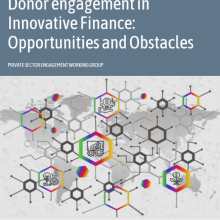Donor Engagement in Innovative Finance: Opportunities and Obstacles

Donor engagement in innovative finance
Donor agencies seek to engage the private sector for development results. This paper represents a first step to explore concepts around leveraging private finance for achieving the Sustainable Development Goals (SDGs). It critically reviews four concepts that frequently feature in current discussions: Innovative Finance (often used as an umbrella term for approaches to leverage additional finance as well as other practices), Blended Finance, Impact Investing, and Results-Based Finance.
Recommendations
This working paper is a primer on “innovative finance”, a catch-all term that refers to a range of strategies to effectively generate, combine, and use public and private financing to achieve a range of development goals and impact. This umbrella term is also used to describe blended finance, impact investing, and results-based finance, which are being adopted and implemented by an increasing number of international donor and development agencies to fund social impact-generating firms and enterprises.
The private sector is encouraged to engage with these donors and development agencies, and help address four critical needs:
- Standard definitions and discourse: The growing importance of innovative finance approaches in donor strategies and budgets has not been matched by greater clarity and consistency of definitions. There are different and conflicting views on what blended finance is, on what qualifies as impact investment, and what results-based finance means. If donors are to accelerate understanding of and learning on effective practice, they will need to develop a shared understanding and more precise use of terminologies with their stakeholders, particularly the private firms and enterprises they intend to serve.
- Effectiveness and evidence of results: A review of key studies reveals that evidence of results of innovative finance interventions is largely fragmented and generally scarce. Emerging data and information on finance leveraged, on changing investor perceptions, and targeted case studies, however, provide an encouraging basis for future work. Donor agencies and their clients are called to explore further and support more effective results measurement across different innovative finance approaches and instruments.
- ‘Best fit’ roles for donors: Rapid expansion of innovative finance engagements has led to a shift in responsibilities of donors and development finance institutions (DFIs), which entails a more strategic understanding of the roles best played by donors. Some donors now use grants as risk mitigation instruments and are lending to, or investing in, business without involvement of DFIs. Private sector clients can be engaged in further research on the effectiveness of specific approaches and instruments, and in building the pipeline of investable projects through traditional private sector development approaches.
- Donor capacity for new roles: Despite their increased engagement in innovative finance, donor agencies tend to have limited expertise and experience in sharing and managing risk. Many donors have started to explore implications for staff recruitment, training, and participation in knowledge exchange with various stakeholders, including the private sector.
Innovative finance refers to a range of strategies to make effective use of, and/or generate financial resources to achieve international development goals. It is comprised of a mix of innovations in raising public or private finance, and in how traditional aid funds are spent on the ground.
In practice, innovative finance is often used as a catch-all term to describe, among others, blended finance, impact investing and results-based finance. These are three potentially related but fundamentally different concepts, each of which represent large fields of practice. Broadly speaking, “blended finance” refers to approaches for raising or leveraging additional finance for development purposes using a wide range of financial instruments, “impact Investing” largely focuses on how private capital is deployed for development purposes, and “result-based finance” refer to a specific group of financial instruments for encouraging more effective and efficient use of private finance and implementation capacity towards the SDGs.
This paper presents a simple overview of these three innovative financing strategies and general information on how blended finance facilitates development financing through combinations of public and private investments; how impact investing is attracting more private sector players (including at the domestic and individual levels) and converging with blended finance to channel additional finance into impact investment; and how results-based finance (or payment by results) deploy performance-based incentives to boost the delivery of targeted outcomes and impact. Donors and private investors/investees are still exploring ways to engage in innovative finance, and are encouraged to work together to sharpen definitions and discourse, strengthen effectiveness and impact assessment to generate evidence, review ‘best fit’ roles for donors, and enhance their capacity for new roles (from finance providers to finance intermediaries). Recommendations for future work by the DCED and other organizations include deepening understanding of specific financial instruments among donor staff, expanding DCED’s work on mitigating negative market distortions caused by innovative finance interventions, and facilitating exchanges with DFI networks to calibrate new donor roles and responsibilities.